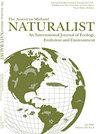普通夜鹰(Chordeiles minor)在不同年份之间缺乏觅食地点的保真度
IF 0.6
4区 环境科学与生态学
Q4 Agricultural and Biological Sciences
引用次数: 1
摘要
摘要白头翁科的鸟类通常表现出很高的筑巢地点保真度,但不知道保真度是否延伸到觅食地点,特别是普通夜鹰(Chordeiles minor),这是研究最多的物种之一。普通夜鹰在生态学上与其他菊科动物截然不同,是少数真正的空中叫卖物种之一,也是该群体中距离最远的候鸟之一。我们预测这些鸟会在几年之间对加拿大不列颠哥伦比亚省的一个觅食地点表现出忠诚,在那里它们会在夜间大量觅食,并且同样的个体会在夜间返回。我们将个体绑在一起,并为一部分鸟类安装了设定好的发射器,以便在明年返回觅食区域时激活。我们估计,我们标记了大约10%在该地点觅食的鸟类,但在随后的两年里,尽管捕获了可能在该地点觅食的50%的鸟类,但没有再捕获一只标记过的鸟类。此外,我们没有发现任何具有无线电发射器的鸟类子集,这表明它们在最初捕获后的一年内没有返回觅食地点。我们的数据表明,与该物种筑巢的公开记录和对该群体的普遍期望相比,对觅食地点的年份之间的保真度很低。本文章由计算机程序翻译,如有差异,请以英文原文为准。
Lack of Foraging Site Fidelity Between Years by Common Nighthawks (Chordeiles minor)
Abstract. Birds in the family Caprimulgidae generally exhibit high nest site fidelity, but it is not known if fidelity extends to foraging sites, especially for Common Nighthawks (Chordeiles minor), which are otherwise one of the most studied species. Common Nighthawks are ecologically distinct from other caprimulgids, being one of the few true aerial hawking species and among the longest distance migrants in the group. We predicted these birds would exhibit fidelity between years to a foraging site in British Columbia, Canada, where they forage in large numbers on a nightly basis and the same individuals return nightly. We banded individuals and, for a subset of birds, attached transmitters programmed to activate upon return to the foraging area the next year. We estimate we marked approximately 10% of the birds foraging at the site, but did not recapture a single marked bird despite capturing potentially 50% of birds foraging at that site over the two subsequent years. Furthermore, we did not detect any of the subset of birds with radiotransmitters, indicating they did not return to the foraging site in the year following initial capture. Our data suggest low fidelity between years to a foraging site, in contrast with the published records for nesting by this species and with the general expectations for the group.
求助全文
通过发布文献求助,成功后即可免费获取论文全文。
去求助
来源期刊

American Midland Naturalist
环境科学-生态学
CiteScore
1.20
自引率
0.00%
发文量
38
审稿时长
18-36 weeks
期刊介绍:
The American Midland Naturalist has been published for 90 years by the University of Notre Dame. The connotations of Midland and Naturalist have broadened and its geographic coverage now includes North America with occasional articles from other continents. The old image of naturalist has changed and the journal publishes what Charles Elton aptly termed "scientific natural history" including field and experimental biology. Its significance and breadth of coverage are evident in that the American Midland Naturalist is among the most frequently cited journals in publications on ecology, mammalogy, herpetology, ornithology, ichthyology, parasitology, aquatic and invertebrate biology and other biological disciplines.
 求助内容:
求助内容: 应助结果提醒方式:
应助结果提醒方式:


